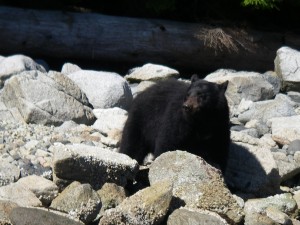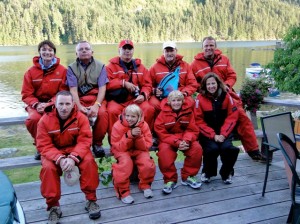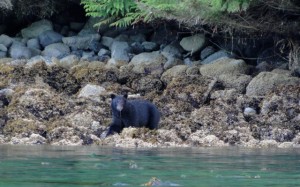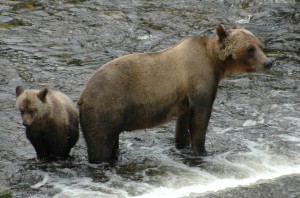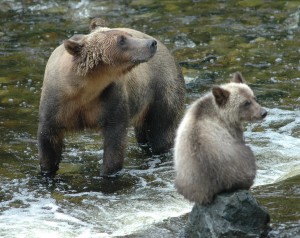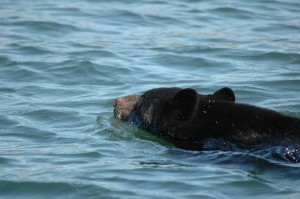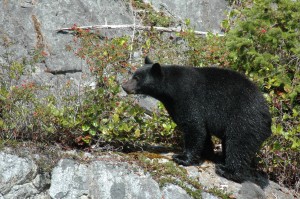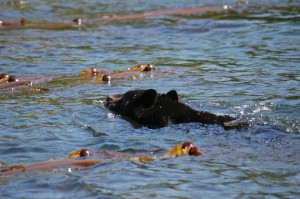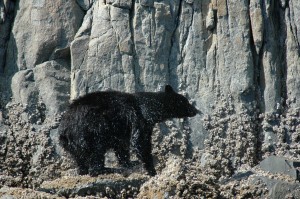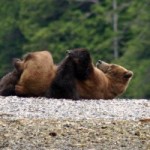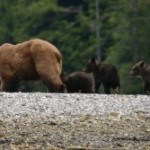Tag Archives: Bears
Evening black bear tour
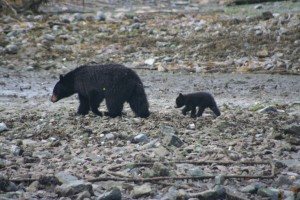 On the first evening at the lodge, if the permits, you set out on a short local trip to view Black Bear feeding on the beach. The “tide permits” is important because you need a low tide to have a beach to give the black bears some palace to turn over rocks to look for high protein food made up of crab, clams, muscles, barnacles, amphipods and other tiny invertebrates. The coastal black bears are small compared to the grizzlies, as they do not have access to the salmon rivers because of the grizzlies. The bears only grow to the size that access to food permits the more protein rich the food the larger the bear. The first year cubs follow their mother closely and take clues from them to determine what is “good food”.
On the first evening at the lodge, if the permits, you set out on a short local trip to view Black Bear feeding on the beach. The “tide permits” is important because you need a low tide to have a beach to give the black bears some palace to turn over rocks to look for high protein food made up of crab, clams, muscles, barnacles, amphipods and other tiny invertebrates. The coastal black bears are small compared to the grizzlies, as they do not have access to the salmon rivers because of the grizzlies. The bears only grow to the size that access to food permits the more protein rich the food the larger the bear. The first year cubs follow their mother closely and take clues from them to determine what is “good food”.
Black Bear Cubs
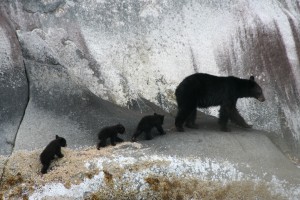
A common saying at the lodge is “black bears are where you find them” meaning that on all tours whether for grizzlies, whales, or the extra day at the river we are always looking for and finding black bears. In this case it was a June trip up Knight Inlet for a morning run to the grizzly bears that Glen took this photo of a black bear and her triplets. Twin cubs are common triplets less so but not rare. These cubs are likely three to for months old being born in their den February. Many of the black bears is the area have come to accept boat traffic and do not necessarily run for the nearest tree as this mother indicates by her stroll along the rocky shore.
The Four Austrians 4 of 11
The lodge normally accommodates eight guests. This means that you interact with the other guests and the staff on a full time basis unless you prefer the privacy of your room. The mornings on the water are be cool so we provide the “floater suites” to keep you warm. They are your “Personal Floatation Device” and even if you choose not to wear them they need to be with you in the boat. After snack time the guides will bring out the suited to make sure you have one that fits this taken care of it is time for your first “quest” for wildlife. The first evening we do a tour looking for black bear and eagles in the vicinity of the lodge, normally an hour or so before or after dinner depending on the tide. The black bears are on the beach looking for food so we need a reasonably low tide to provide the beach. If we don’t have success on the first evening most days we find black bears while on a grizzly or whale tour. This evening was successful.
Cubs waiting to for salmon
The mother grizzly bears on the Glendale River bring their cubs with them when they come to fish. These first year cubs born in January or February are waiting patiently for a meal to be provided. One is lucky in that it has a dry rock to sit on while the other looks less sure balanced on a wet and likely slippery rock. It is not uncommon to have an age mixture in the grizzly bears we view from the stands in the fall. A mixture from first year cubs with mothers, sub-adult bears as well as fulls adults. The abundance of salmon to eat and the short time to fatten for the winter does not allow time for much fighting.
Grizzly Bear Claws
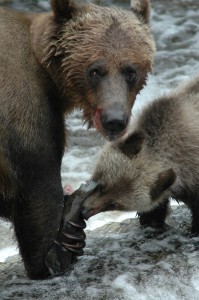
The “North American Bear Center” website says “Brown bear (grizzly bear) claws are long and curved, ranging in color from yellow to brown. In rare cases grizzlies have been observed with white claws.” This seems rather mundane and clinical until you actually look carefully at this picture. Click on the picture to enlarge it and you will notice the size of the claws. A quote from the “Fish BC” website about the pink salmon this grizzly is holding is interesting. “Easily identified by the large browny spots on their tails, pink sport aquamarine dorsal surfaces, the tiniest bright silver scales in the ocean and an over-abundance of disease-preventing slime. Accordingly, commercial fishers call them “slimies”. And they are slimy indeed. The angler is cautioned to clean up the boat after each salmon or risk ending up in the water with the rest of them.” Slime or no slime this grizzly holds the salmon in one paw while she shares with her cub. Notice that the claw raps around the fish from both sides like a hand. If you stay in the lodge the extra day and travel to the wild river many of the grizzlies in that area have the white claws.
Grizzly Bear Looking into Camera
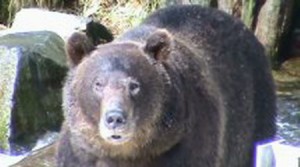
Some time one is not to sure if we are watchers or if the grizzly bears are in charge. In this case it appears that our guests Mike and Christina from Florida were caught taking the picture on the Glendale River. In the fall, after August 24, we are permitted to drive to viewing stands on the river to watch the bears feed on the salmon that have returned to the man-made spawning channel. The grizzly bears in the area have accepted our intrusion and tend to ignore us however every once in a while the tables seemed to be turned in their favour.
Black Bear Island Hopping – Set II
Click on photo to enlarge
The bear left the small island for a larger one although this one was not much more than half and acre in size. This was in late August so the bear was starting to produce a reasonable layer of fat this is indicated by how far the head and shoulders are out of the water. In the spring all only the head would be visible the back under water. All in all the bear passed over three small islands until it reached Tourner Island which is close or ten miles long. The red “berries” are rose hips, which are the fruit from of a wild rose bush. As guides spending our summers in the area on the east coast of Vancouver Island and the water of Knight Inlet working for Grizzly Bear Lodge we all have been with the lodge for at least ten years and in the area for twenty-five years or more. We rely on experience in our boat handling and knowledge of the area but luck is a great companion with wildlife viewing ask any wildlife photographer.
Black Bear Island Hopping – Set I
Click photos to enlarge
This sequence of photos was memorable as it shows that “luck” plays an important part in making a day memorable for guests. We were on our way back to the lodge from whale watching in the area of Johnstone Strait our boat containing myself and the Edourad family from France was a little slower than the other lodge boat by about five minutes. We came to a small passage between a series of islands in Beware Passage to find a black bear swimming. It was coming to the first small island and passed through the kelp bed along the shore without a problem. It climbed up the shore shook off the excess water and crossed over to the back of the island….. see tomorrow’s post
Grizzly Bear Mother Nursing – Set II
Click photo to enlarge and see ALL of the bear!
